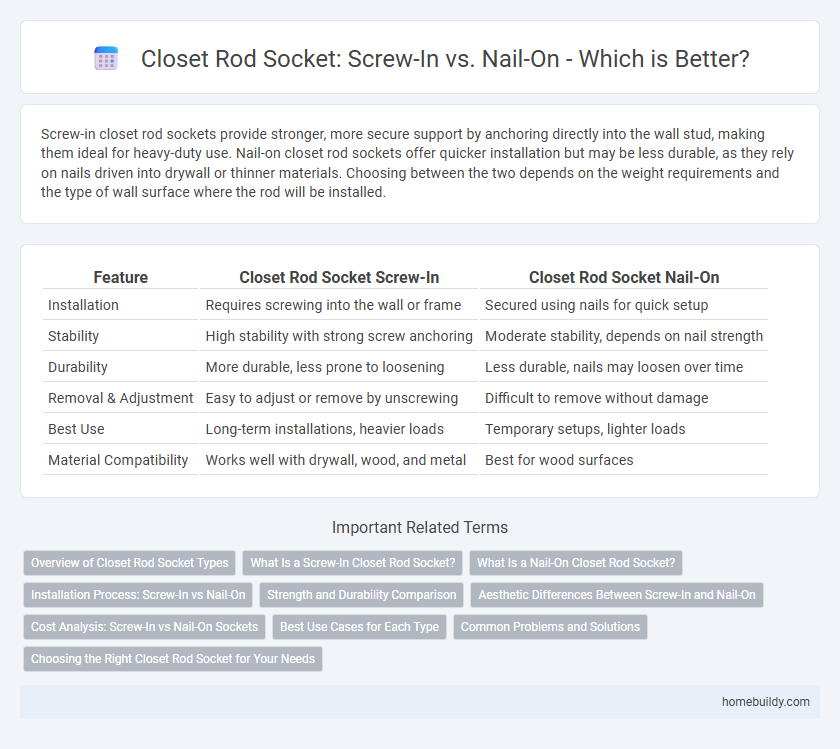Screw-in closet rod sockets provide stronger, more secure support by anchoring directly into the wall stud, making them ideal for heavy-duty use. Nail-on closet rod sockets offer quicker installation but may be less durable, as they rely on nails driven into drywall or thinner materials. Choosing between the two depends on the weight requirements and the type of wall surface where the rod will be installed.
Table of Comparison
| Feature | Closet Rod Socket Screw-In | Closet Rod Socket Nail-On |
|---|---|---|
| Installation | Requires screwing into the wall or frame | Secured using nails for quick setup |
| Stability | High stability with strong screw anchoring | Moderate stability, depends on nail strength |
| Durability | More durable, less prone to loosening | Less durable, nails may loosen over time |
| Removal & Adjustment | Easy to adjust or remove by unscrewing | Difficult to remove without damage |
| Best Use | Long-term installations, heavier loads | Temporary setups, lighter loads |
| Material Compatibility | Works well with drywall, wood, and metal | Best for wood surfaces |
Overview of Closet Rod Socket Types
Closet rod sockets come in two primary types: screw-in and nail-on, each designed for specific installation needs. Screw-in sockets offer a secure, adjustable fit by threading directly into the wall or cabinet, providing greater durability and ease of removal or repositioning. Nail-on sockets are fastened with nails directly into wooden surfaces, offering a quick, cost-effective solution but with less flexibility and holding strength compared to screw-in options.
What Is a Screw-In Closet Rod Socket?
A screw-in closet rod socket is a type of hardware designed to securely hold a closet rod by fastening directly into the wall or cabinet surface with screws. This mounting method provides superior stability and durability compared to nail-on sockets, making it ideal for supporting heavier loads. Screw-in sockets typically feature threaded holes that accommodate screws, ensuring a firm attachment that prevents the rod from loosening over time.
What Is a Nail-On Closet Rod Socket?
A nail-on closet rod socket is a type of mounting hardware designed to secure a closet rod using nails instead of screws. This style allows for quick installation by hammering the socket directly into the wall stud or wooden surface, providing a firm grip for the rod. Nail-on closet rod sockets are commonly used in lightweight closet systems where ease of assembly outweighs the need for heavy-duty support.
Installation Process: Screw-In vs Nail-On
Closet rod socket installation varies significantly between screw-in and nail-on types, impacting ease and durability. Screw-in sockets require pre-drilled holes and provide a secure, adjustable fit by fastening with screws, making them ideal for heavier loads and frequent adjustments. Nail-on sockets allow for quicker installation by nailing directly into wood surfaces, offering convenience but potentially less stability under heavy usage.
Strength and Durability Comparison
Closet rod socket screw-in models provide superior strength and durability due to their secure attachment within the wall or frame, minimizing wobble and bearing heavier loads without loosening over time. Nail-on sockets, while easier to install, generally offer less holding power and may loosen or pull away under continuous strain, especially with heavier closet rods. For long-term robustness and safety, screw-in closet rod sockets are the preferred choice in both residential and commercial applications.
Aesthetic Differences Between Screw-In and Nail-On
Screw-in closet rod sockets offer a cleaner, more polished appearance due to their flush installation and minimal visible hardware. Nail-on sockets tend to show exposed nails or heads, which can detract from the overall neatness of the closet interior. Choosing screw-in sockets enhances the aesthetic appeal by providing a seamless look that complements modern closet designs.
Cost Analysis: Screw-In vs Nail-On Sockets
Screw-in closet rod sockets generally cost more upfront due to their durable metal construction and threaded installation, ensuring stronger support for heavy loads. Nail-on sockets are typically less expensive and quicker to install, made from lighter materials suitable for moderate weight but may require replacements over time. Considering long-term durability and maintenance, screw-in sockets offer better value despite higher initial costs.
Best Use Cases for Each Type
Closet rod socket screw-in models offer superior stability and are best suited for heavy-weight closets or areas requiring frequent adjustments, making them ideal for long-term installations. Closet rod socket nail-on types provide quick and easy mounting, perfect for lightweight closets or temporary setups where rapid installation and removal are priorities. Both options optimize space utilization but should be chosen based on the specific load capacity and installation permanence required.
Common Problems and Solutions
Closet rod socket screw-in types often face issues like stripping threads or loosening over time, which can be resolved by using screws with improved thread design or applying thread-locking adhesive. Nail-on closet rod sockets frequently experience loosening or damage to the surrounding wood, effectively fixed by using longer or thicker nails and reinforcing the mounting surface with wood filler or backing plates. Selecting the right mounting method based on material stability and load requirements ensures long-lasting, secure closet rod installation.
Choosing the Right Closet Rod Socket for Your Needs
Choosing the right closet rod socket depends on the installation surface and load requirements; screw-in closet rod sockets offer stronger, more secure attachment ideal for drywall or sturdy wood, while nail-on sockets provide quicker, easier installation suited for softer materials or temporary setups. Consider the weight of the closet rod and items to be hung, as screw-in sockets typically support heavier loads and ensure long-term stability. Proper selection ensures optimal durability, safety, and ease of installation for your closet organization project.
Closet rod socket screw-in vs Closet rod socket nail-on Infographic

 homebuildy.com
homebuildy.com